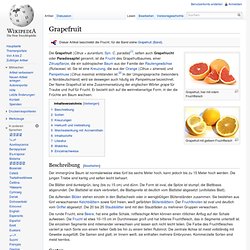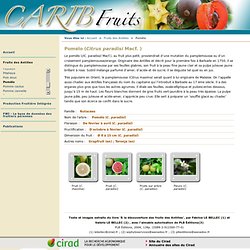

Citrus paradisi Hybrids and Cultivars. Grapefruit. Grapefruit, hier mit rotem Fruchtfleisch Grapefruit mit gelbem Fruchtfleisch Beschreibung[Bearbeiten] Der immergrüne Baum ist normalerweise etwa fünf bis sechs Meter hoch, kann jedoch bis zu 15 Meter hoch werden.

Die jungen Triebe sind kantig und selten leicht behaart. Die Blätter sind dunkelgrün, lang (bis zu 15 cm) und dünn. Sorten[Bearbeiten] Grapefruit rosé Die verschiedenen Sorten der Grapefruit unterteilen sich in zwei Hauptgruppen: Kreuzungen[Bearbeiten] Die Sorte Oroblanco, eine Kreuzung zwischen Citrus maxima 'Siamese Sweet' und Citrus paradisi 'Marsh' , wird im Handel als Sweetie angeboten Herkunft und Verbreitung[Bearbeiten] Man nimmt an, dass die Grapefruit um 1750 aus einer spontanen Kreuzung zwischen der Pampelmuse und der Orange auf Barbados entstanden ist. 1823 gelangte sie nach Florida, wo sie seit 1875 kommerziell angebaut wird[3].
Grapefruit. Tart and tangy with an underlying sweetness, grapefruit has a juiciness that rivals that of the ever popular orange and sparkles with many of the same health promoting benefits.

Although available throughout the year, they are in season and at their best from winter through early spring. Grapefruits usually range in diameter from four to six inches and include both seed and seedless and pink and white varieties. The wonderful flavor of a grapefruit is like paradise as is expressed by its Latin name, Citrus paradisi.
Grapefruit, pink, fresh0.50 medium(128.00 grams) NutrientDRI/DV This chart graphically details the %DV that a serving of Grapefruit provides for each of the nutrients of which it is a good, very good, or excellent source according to our Food Rating System. Health Benefits Rich in the Nutritional Powerhouse Vitamin C Grapefruit is an excellent source of vitamin C, a vitamin that helps to support the immune system. Enjoy Benefits from the Antioxidant Lycopene Dr. Description History. Pomélo. Le pomélo (//C. paradisi// Macf.), au fruit plus petit, proviendrait d’une mutation du pamplemousse ou d’un croisement pamplemousse/orange.

Originaire des Antilles et décrit pour la première fois à Barbade en 1750, il se distingue du pamplemousse par ses feuilles glabres, son fruit à la peau fine jaune clair et sa pulpe juteuse jaune brillant à rose. Subtil mélange parfumé d’amer, d’acide et de sucré, il se déguste tel quel ou en jus. Très populaire en Orient, le pamplemousse (Citrus maxima) serait quant à lui originaire de Malaisie.
On l’appelle aussi chadec aux Antilles françaises du nom du capitaine qui l’introduit à Barbade au 17 ème siècle. Il a des organes plus gros que tous les autres agrumes. Famille : Rutacées Nom de l'arbre : Pomélo (C. paradisi) Floraison : De février à avril (C. paradisi) Grapefruit. By using our site, you consent to this privacy policy: This website allows third-party advertising companies for the purpose of reporting website traffic, statistics, advertisements, "click-throughs" and/or other activities to use Cookies and /or Web Beacons and other monitoring technologies to serve ads and to compile anonymous statistics about you when you visit this website.

Cookies are small text files stored on your local internet browser cache. A Web Beacon is an often-transparent graphic image, usually no larger than 1 pixel x 1 pixel that is placed on a Web site. Both are created for the main purpose of helping your browser process the special features of websites that use Cookies or Web Beacons. The gathered information about your visits to this and other websites are used by these third party companies in order to provide advertisements about goods and services of interest to you. Grapefruit. Description[edit] Grapefruit growing in the grape-like clusters from which their name derives.

The evergreen grapefruit trees usually grow to around 5–6 meters (16–20 ft) tall, although they can reach 13–15 meters (43–49 ft). The leaves are glossy dark green, long (up to 15 centimeters (5.9 in)) and thin. It produces 5 cm (2 in) white four-petaled flowers. The fruit is yellow-orange skinned and generally an oblate spheroid in shape; it ranges in diameter from 10–15 centimeters (3.9–5.9 in). History[edit] One ancestor of the grapefruit was the Jamaican sweet orange (Citrus sinensis), itself an ancient hybrid of Asian origin; the other was the Indonesian pomelo (C. maxima).
FORBIDDEN-FRUIT-TREE The Trunk, Leaves, and Flowers of this Tree, very much resemble those of the Orange-tree. —Description from Hughes' 1750 Natural History of Barbados. The hybrid fruit, then called "the forbidden fruit", was first documented in 1750 by a Welshman, Rev. Kimball Chase Atwood Ruby Red[edit]